Gripping tightly onto a walking stick, I slowly and precariously make my way through the forest. Careful not to catch my prosthetic foot on the exposed roots, I’m scanning the ground when I see a disfigured branch, gnarled, with burls and nodules on it. These masses—called “galls”—are a common growth mutation that can be caused by various factors: bacteria, insects, and rapid changes in weather. I grew up on a fruit tree farm, so I’ve seen this before, but a different familiarity, like a kinship, spurred me to take the branch home. I soon became obsessed with the idea of “tree tumors” and the aesthetics of mutation in nature as a beautiful and intriguing expression of disease and disability. They evoked memories of the way seeing my medical scans eased the abject fear of my cancer – even though the scans felt alien and depersonalized from me, they offered a concrete visual anchor that demystified my diagnosis.
In my art practice, I have sought to create similar feelings of kinship and touchstones for disability. By producing artworks that feature disease and disruption in beautiful ways, I resist notions of “cure” and “pathology,” opting instead to highlight the prolonged “living-with” that more accurately reflects disabled lives. The traditional medicalized notion of disability has been used to define features of marginalized communities, and to reinforce colonial authority to justify dehumanization and discrimination (Schalk 2022). Through collaboration with disabled people and plants, I seek to re-historize conceptions of disability and create an archive of disability culture. Specifically, a culture that is often conjured out of survival and performed through activist affordances, a theory developed by my collaborator and advisor Arseli Dokumaci.
Activist affordances “name and recognize the tiny, everyday artful battles of disabled people for more liveable worlds that otherwise remain unaccounted for” (Dokumaci 2023). Disability exists beyond the body, in what Alison Kafer calls the political/relational model of disability (Kafer 2013). I represent that relationality by straying away from documentary, representational depictions of the disabled body, instead subverting it through animation, film and sculpture. My aesthetic explorations of how to represent disability are extended through rigorous material experimentation. Often, glitches and failed prototypes become critical parts of the work, because it recognizes an intimacy with constraint, limitation or “shrinkage” (Dokumaci 2023) that disability can embody. I enjoy finding novel methods to embody the improvisation and ingenuity of disabled identity.
My projects, The Disabled Body In Motion (DBIM) and Floral Fasciation, are attempts to create alternative disability histories. Both projects explore the notions of disruptions in grace and the invention of new ways of being. The Disabled Body in Motion serves as an introduction to disability extending beyond the body and abstracting the disabled form. Floral Fasciation goes beyond human representations of disabled culture by using mutant plants as embodied disability objects. These two projects aim to bring disability and disabled people into discourses around survival, anthropology and natural sciences. For people engaged in disability justice, it offers an updated aesthetic of disability that can be used to more accurately represent our critical grounding.
The Disabled Body in Motion
In The Disabled Body in Motion, I address how medicalisation, fetishization, and taxonomies of difference impact how we view disabled bodies. I worked with 4 disabled performers, who created 3 choreographies each, featuring their everyday activist affordances. These rituals spanned from imperceptible, such as lightly swaying from the core to stay balanced due to muscular dystrophy, to more obvious, like using a gripper to reach objects, or stretching for pain management. The 12 videos are installed in small 5 x 7 inch acrylic shadowboxes, like taxonomical specimens you’d see at a natural history museum. It features an audio description of performer interviews, exploring how their bodies are perceived, their relationship to motion, and their unique experiences of disability in relation to their intersecting identities.
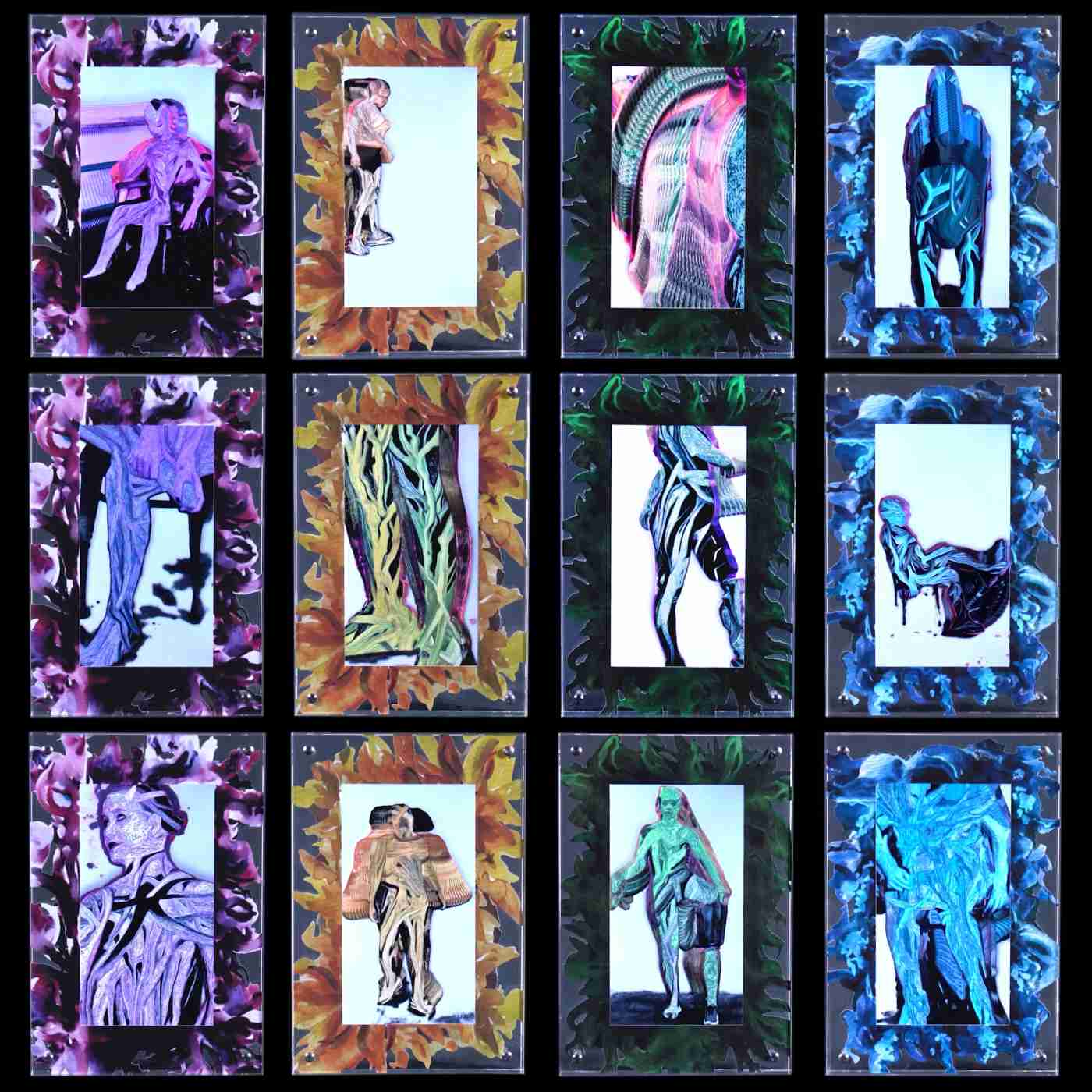
Animations from the Disabled Body in Motion. Image by author.
After trialing several animation techniques, I chose rotoscoping which involved digitally drawing over each frame of the footage. The long drawing process immersed me in the micro-movements of each performance. Retracing the movements was an act of solidarity and appreciation for the craft and technique cultivated in disabled movement. I discovered an AI program for rotoscoping that filled the gaps in the videos between my thousands of rotoscoped images. The AI introduced an undulating effect within their forms, amplifying every subtle change in light and movement. By incorporating these glitches, the work challenges animation’s usual prioritization of grace and smoothness as the defining markers of beauty and realism. Instead, the project foregrounds a different realism—one that embraces the limping rhythm of a body as it moves a 15-pound prosthesis, and the knottedness of muscles working with and against a body trying to remain upright. I assembled each frame so that it stacked on the frame before, crystalizing the full range of each temporal movement. These composite images allow disabled movement (and bodies) to take up space; the prior positions of their limbs leave imprints behind them as they move, and these forms continue beyond their screen, onto their acrylic frames. The patterns created are reminiscent of botanical or entomological illustrations of an insect’s wingspan, not a typical human form.
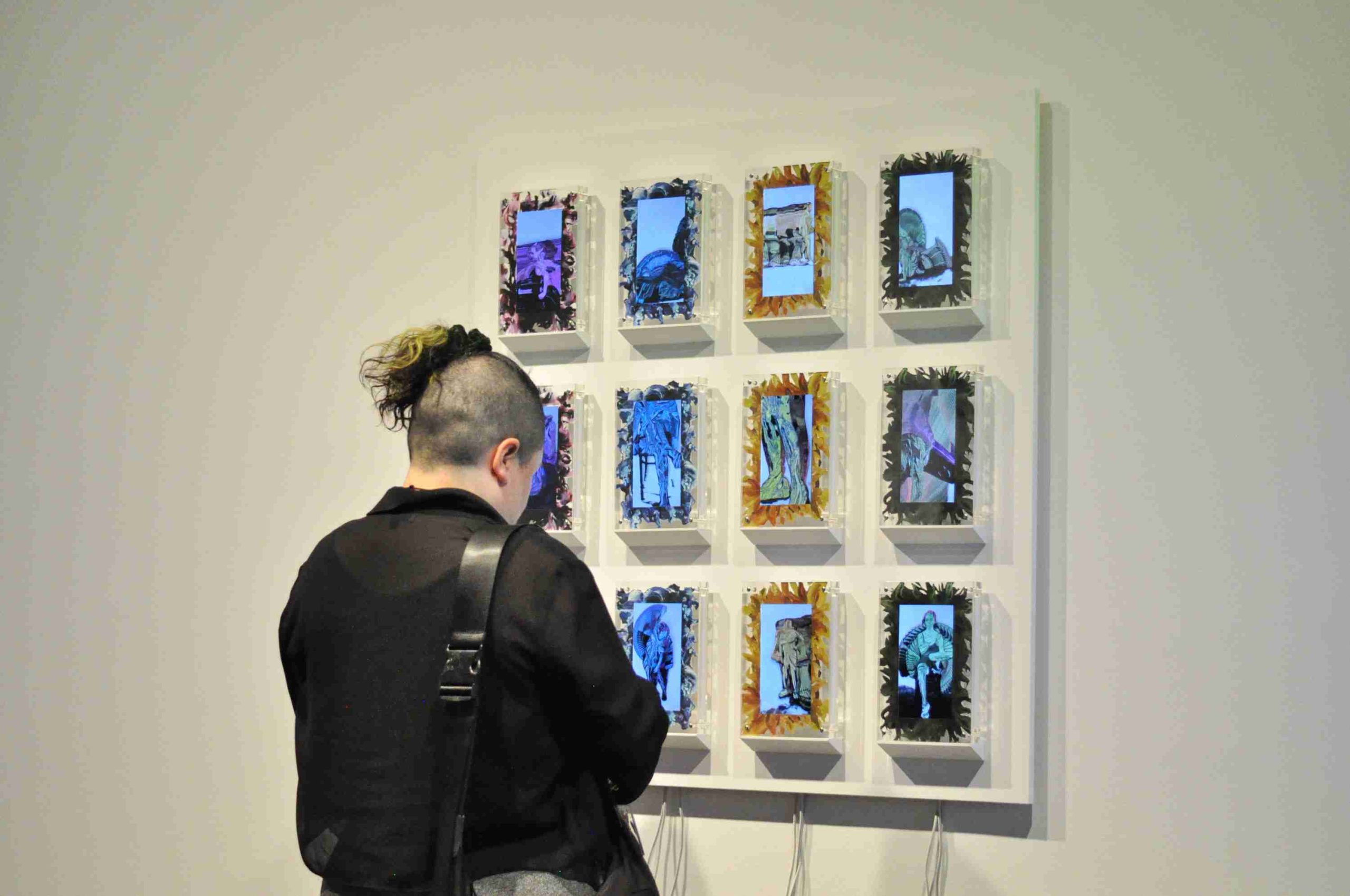
A viewer watches animations that are a part of the Disabled Body in Motion. Image by author.
The work is a reminder of the historical taxonomies that depicted disabled bodies as medical spectacle and anomaly. The animations reference early motion studies photography like that of Eadward Muybridge and Étienne-Jules Marey, which were used to document typical movement, but also to typify deviances (Maxwell 2010). With the 12 frames assembled and playing together, The Disabled Body in Motion is a showcase of the everyday interventions disabled people invent to navigate their environments.
Floral Fasciation
I found the branch with galls on it halfway through making The Disabled Body in Motion. I was already abstracting the human form, but wanted to push that further, while also featuring my new obsession – mutant flowers. I felt that drawing parallels between human and non-human disability could help represent the inherent resilience in living with disease and difference (Dokumaci 2023). Floral fasciation is defined as abnormal growth mutation in plants, typically through fused or conjoined petals, crested appearances or elongation. I’m using Floral Fasciation to refer to a cluster of projects, beginning from a collaboration with Arseli Dokumaci, which asked “How can plant mutations allow us to reimagine disability as a valuable form of biodiversity?” (Access in the Making Lab nd; Engage Program 2022). With Arseli’s guidance, I’m undertaking ethnographic research that tracks my process of collecting, growing and discovery of fasciated flowers. I’m also drawing from this research to create a multi-media exhibition that incorporates real fasciated flowers which I’ve collected and grown, and various resin, 3D printed sculptural versions, along with corresponding interactive animations that feature digital versions of mutant plants.
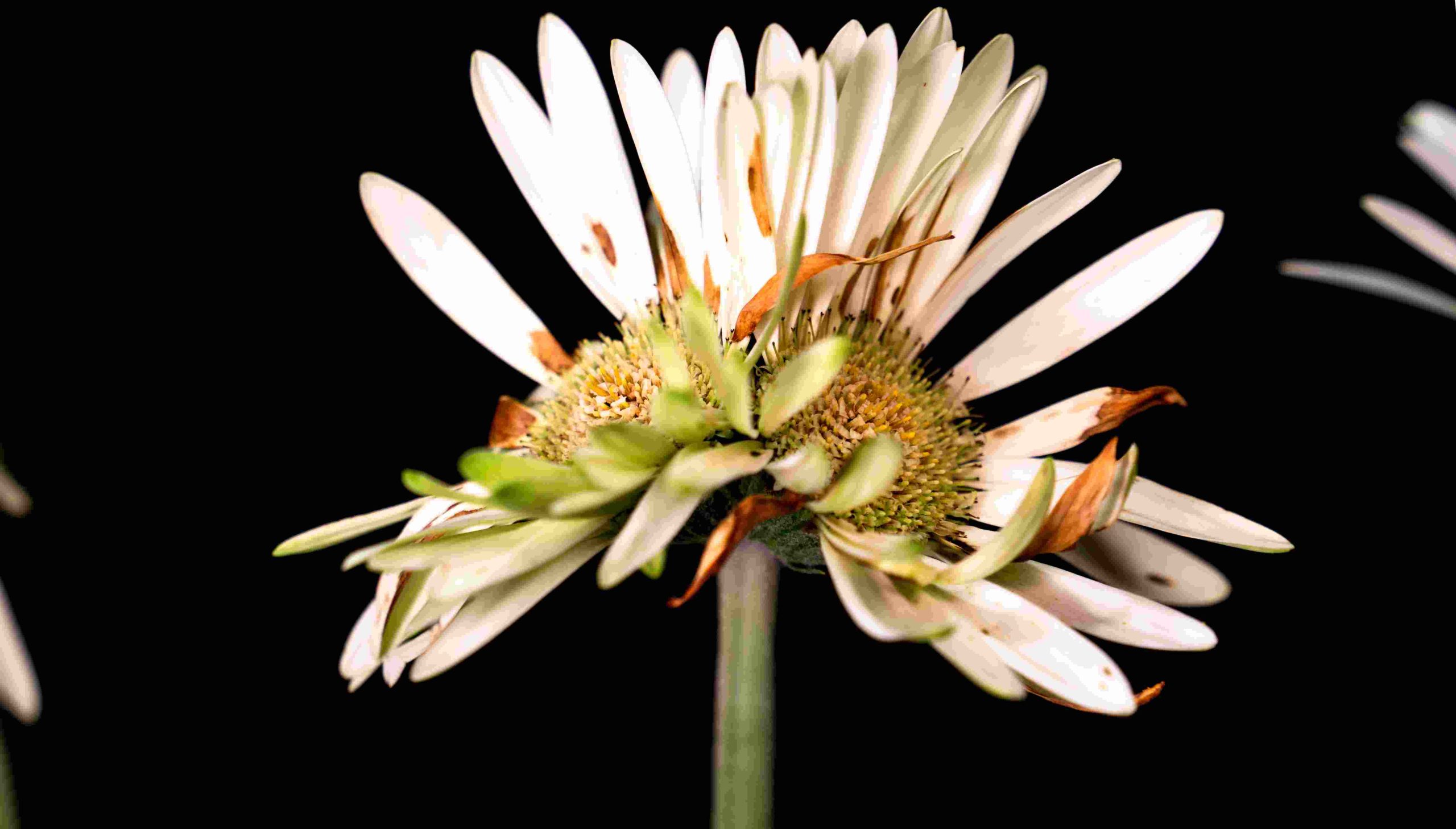
Image of a conjoined fasciated daisy. Image by author.
The general public would likely not consider environmental degradation, or mutations in plant life as “disabilities” despite the connections between them. Famously, in the exclusion zone around Chernobyl, plants have mutated at much higher rates (Mousseau and Moller 2020). Plants have been bioengineered to mutate if there are particular chemicals in soil, for use as bio-markers (Aina et al. 2024). And, disabled people are disproportionately at-risk to the dangers posed by climate change (Stein et al. 2023). Fasciated flowers have developed differently as a consequence of a random difference, a likelihood that increases with pollution and disruption. In considering mutation as a disability, the concept of disability moves from impairment-focused to survival-focused. Some forms of plant mutation are cultivated: for aesthetic appeal, such as variegation in Rembrandt tulips; or for agriculture, where using biotechnology to breed ideal crops is ubiquitous. There is however, very little interrogation on the less productive or “justifiable” examples of mutation, which is also consistent with how disability can be viewed.
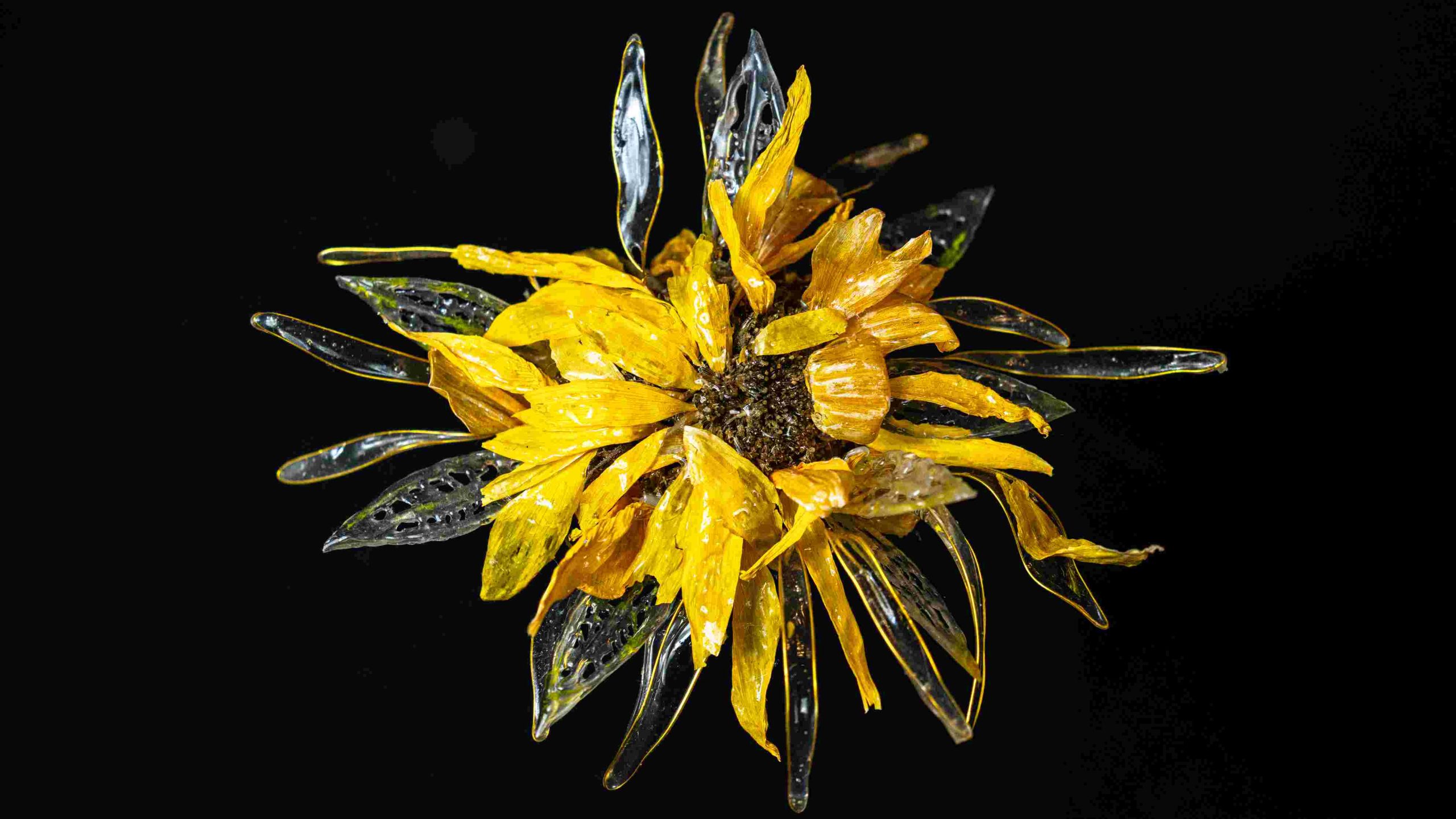
A dried, fasciated sunflower against a black background. Image by author.
I was able to source mutant sunflowers, a gerbera daisy, and others, through lucky finds in gardens, in the wild, and in greenhouses. I documented these “case studies” in mutation through photography, 3D scanning, and preserved them in resin or through drying. In the case of The Sabrina, I combined the real flower with clear resin petals – augmenting it with a further mutation. For this documentation, the focus is split between showcasing various differences honestly, simply showing mutation as an aspect of biodiversity, and reflecting on what mutation means. Their meaning, and the “value” of their disabilities, isn’t framed through notions of natural selection and benefits of particular mutations, but through the adaptability these flowers demonstrate in the act of surviving.
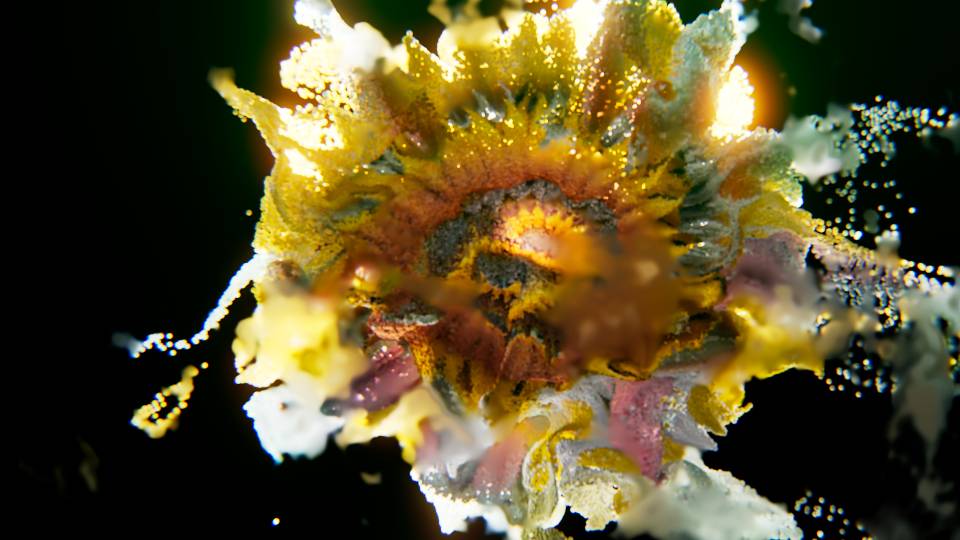
A sunflower with its particles fragmented. Image by author.
In researching examples of mutation in plants I found striking images of fasciated flowers, some with conjoined blooms, others with elongated sepals (centers) that are reminiscent of microscopic imagery of two cells splitting in mitosis. I began to see mutation as a type of dynamism. It was so at odds with the static and passive ideals of disability as synonymous with impairment. To represent this in animations like Particle Sunflower, I used animation software and particle simulators. Simulating physics to affect the models of my flowers felt like an embodiment of how mutation can occur randomly, through infinite and imperceptible triggers, or through intensive influence. Movement became a theme of the work, so that the mutation could be seen as an active and ongoing survival skill like living with disability is.
Disability and mutation can elicit feelings of uncanniness, and historically have been viewed as punishment for sin, as objects of pity or as monstrosities. I felt like allowing viewers to engage with the pieces directly was an opportunity for them to be in more intimate proximity to variation and overcome their aversion to it. The technology used in producing interactive sculptures fit with the theme of translation. Photogrammetry scans and 3D models were translated into 3D printing and silicone casts, with all the imperfections and “mistakes” that come from translation. I became interested in using soft robotics to build flowers that move using airflows controlled by microcontrollers, because of how in-vogue the technology has been in biomedical and engineering circles (NASA 2024). These prototypes in particular, with their straining grips, and halting movements, help embody a less “ideal” yet still ingenious mutation.
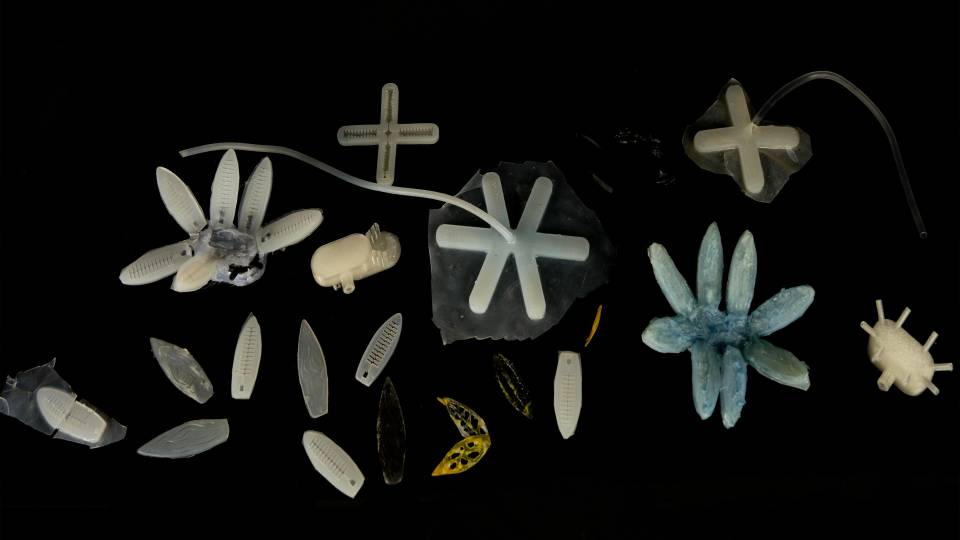
Failed prototypes. Image by author.
Art as Method in Disability Justice
These two projects are ultimately about embracing glitches and failures in the material elements of the works, and their disabled subjects. The Disabled Body in Motion elevates the halting movements, or movements out of reach of disabled peoples’ bodies. The collection of works in Floral Fasciation represents a disabled ecosystem that highlights the value and grace embodied by finding new ways to survive and living with disease. Together, I believe they can help reframe disability and adaptation, by countering the typical techno-solutionism and transhumanist vision that aspires to an eradication of disability through technology, be it the disability of humans, plants, or the planet.
In a context of the climate crisis, understanding the natural beauty of disabled ingenuity, human and nonhuman, becomes necessary, as disabling factors increase. Through my research and artistic works, I challenge the arbitrariness of labeling mutation and disability as singularly good or bad. Instead, I try to promote valuing them for the fact that they represent an adaptive skill, rather than devaluing them as deviances or threats to productivity. These specific case studies offer a template for considering more nuanced and relational models of disability. My work is like a love letter to disability, which is in and of itself radical. For disabled audiences, an artistic language that represents how we see our skills, barriers and bodies can help to unite us by updating our activism’s symbology to match new theories of disability. Broadening the reach of this approach to other disciplines like environmental science, anthropology, biology and medicine would mean that they would be more actively engaging people with lived experience, and not defaulting to isolating the “problem” as located in a body. A cultural aesthetic of disability, explored through examples of disability and mutation, can help highlight disability’s relevance in diverse fields and offer tangible articulations of how disability is tied to survival.
Acknowledgements:
Floral Fasciation is supported through the Fonds de Recherche de Quebec’s Engage Programme⁵, and is being developed through Arseli Dokumaci’s project Mobilizing Disability Survival Skills for the Urgencies of the Anthropocene⁶ at the Access in the Making Lab.
The Disabled Body in Motion was initially supported through the Conseil des Arts de Montreal. Expansions on the work are pending funding.
I would like to acknowledge the invaluable contributions of past and present colleagues at AIM Lab, who have helped me workshop concepts around these projects through our Paper Jams and MDSSA meetings.
I would like to express my heartfelt gratitude to my partner, Oliver Fitzpatrick, whose unwavering support has been integral to my projects. From providing essential access support to both me and my participants in DBIM—carrying wheelchairs and filming equipment—to reviewing this post before publication, Ollie has been involved in every aspect. Thank you for your dedication and care!
This post was curated by Contributing Editor Kim Fernandes.
References
Aina, Omolola, Olalekan O. Bakare, Adewale O. Fadaka, Marshall Keyster, and Ashwil Klein. “Plant Biomarkers as Early Detection Tools in Stress Management in Food Crops: A Review.” Planta 259, no. 3 (February 5, 2024). https://doi.org/10.1007/s00425-024-04333-1
“Beyond the Metal: Investigating Soft Robots at NASA Langley.” NASA, May 10, 2024. https://www.nasa.gov/centers-and-facilities/langley/beyond-the-metal-investigating-soft-robots-at-nasa-langley/
Dokumaci, Arseli. Activist affordances: How disabled people improvise more habitable Worlds. Durham: Duke University Press, 2023.
“Engage Program – Citizen Questions – 2022-2023.” Fonds de recherche du Québec, October 31, 2022. https://frq.gouv.qc.ca/en/engage-program-citizen-2022-2023/. (See “How can natural phenomena be used as a communication tool for disability representation?”)
Kafer, Alison. Feminist, Queer, Crip. Bloomington: Indiana University Press, 2013.
Maxwell, Anne. Picture Imperfect: Photography and Eugenics, 1870-1940. Liverpool University Press, 2010. https://doi.org/10.2307/jj.4116440
“MDSSA – Mobilizing disability survival skills for the urgencies of the Anthropocene.” Access in the Making Lab, https://accessinthemaking.ca/project/mobilizing-disability-survival-skills-for-the-urgencies-of-the-anthropocene/
Mousseau, Timothy A., and Anders Pape Møller. “Plants in the Light of Ionizing Radiation: What Have We Learned from Chernobyl, Fukushima, and Other ‘Hot’ Places?” Frontiers in Plant Science 11 (May 8, 2020). https://doi.org/10.3389/fpls.2020.00552
Schalk, Samantha Dawn. Black Disability Politics. Durham: Duke University Press, 2022.
Stein, Penelope J., Michael Ashley Stein, Nora Groce, and Maria Kett. “The Role of the Scientific Community in Strengthening Disability-Inclusive Climate Resilience.” Nature Climate Change 13, no. 2 (January 9, 2023): 108–9. https://doi.org/10.1038/s41558-022-01564-6

1 Comment
Incredible Em and to Ollie so inspiring